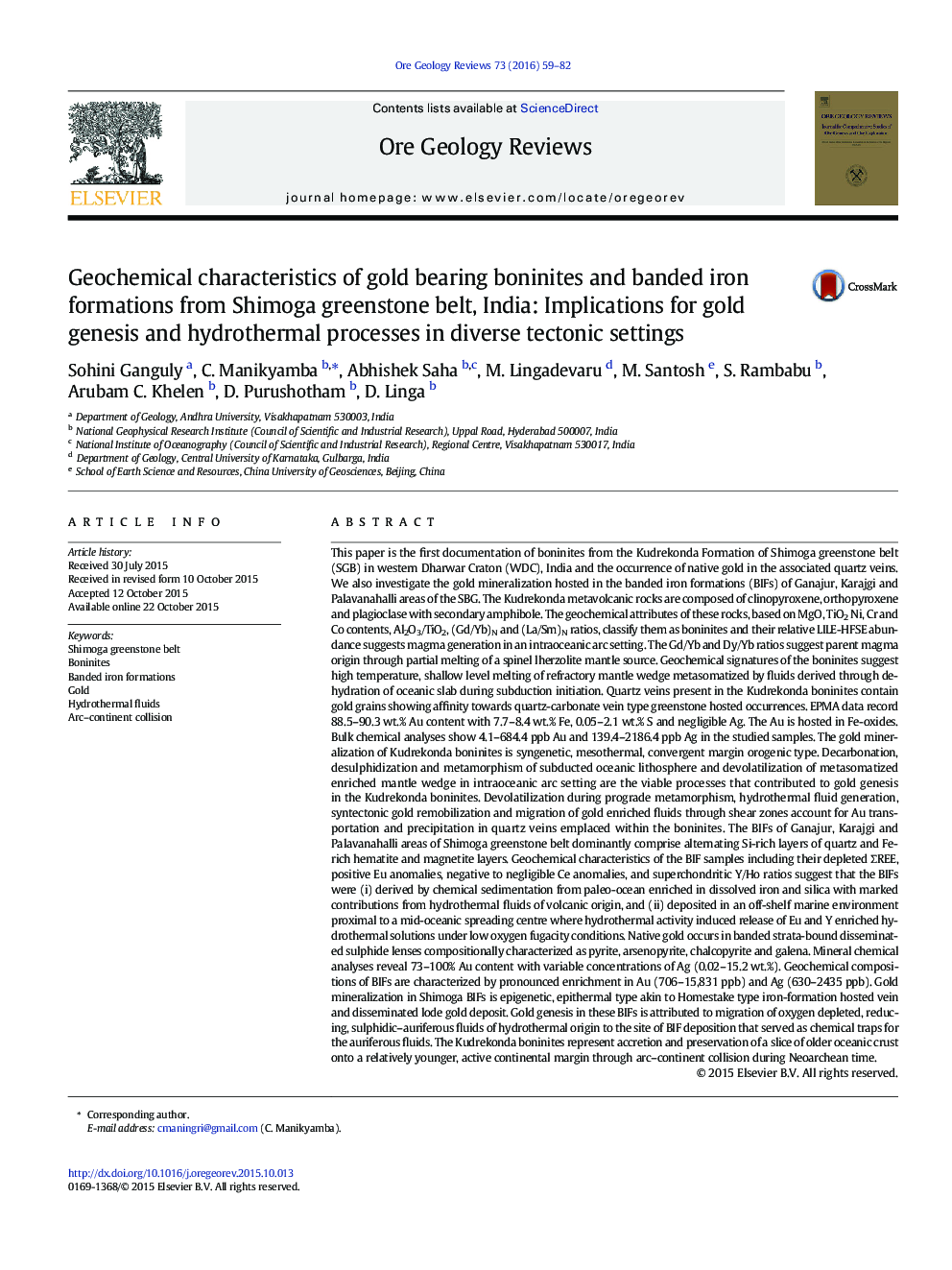| کد مقاله | کد نشریه | سال انتشار | مقاله انگلیسی | نسخه تمام متن |
|---|---|---|---|---|
| 6435869 | 1351862 | 2016 | 24 صفحه PDF | دانلود رایگان |
- First report of boninite, occurrence of gold in boninites and BIFs from Shimoga belt
- Transformation of spreading ridge to intracratonic arc and propagation towards continental margin
- Auriferous fluid sourced from diverse tectonic settings
This paper is the first documentation of boninites from the Kudrekonda Formation of Shimoga greenstone belt (SGB) in western Dharwar Craton (WDC), India and the occurrence of native gold in the associated quartz veins. We also investigate the gold mineralization hosted in the banded iron formations (BIFs) of Ganajur, Karajgi and Palavanahalli areas of the SBG. The Kudrekonda metavolcanic rocks are composed of clinopyroxene, orthopyroxene and plagioclase with secondary amphibole. The geochemical attributes of these rocks, based on MgO, TiO2 Ni, Cr and Co contents, Al2O3/TiO2, (Gd/Yb)N and (La/Sm)N ratios, classify them as boninites and their relative LILE-HFSE abundance suggests magma generation in an intraoceanic arc setting. The Gd/Yb and Dy/Yb ratios suggest parent magma origin through partial melting of a spinel lherzolite mantle source. Geochemical signatures of the boninites suggest high temperature, shallow level melting of refractory mantle wedge metasomatized by fluids derived through dehydration of oceanic slab during subduction initiation. Quartz veins present in the Kudrekonda boninites contain gold grains showing affinity towards quartz-carbonate vein type greenstone hosted occurrences. EPMA data record 88.5-90.3Â wt.% Au content with 7.7-8.4Â wt.% Fe, 0.05-2.1Â wt.% S and negligible Ag. The Au is hosted in Fe-oxides. Bulk chemical analyses show 4.1-684.4Â ppb Au and 139.4-2186.4Â ppb Ag in the studied samples. The gold mineralization of Kudrekonda boninites is syngenetic, mesothermal, convergent margin orogenic type. Decarbonation, desulphidization and metamorphism of subducted oceanic lithosphere and devolatilization of metasomatized enriched mantle wedge in intraoceanic arc setting are the viable processes that contributed to gold genesis in the Kudrekonda boninites. Devolatilization during prograde metamorphism, hydrothermal fluid generation, syntectonic gold remobilization and migration of gold enriched fluids through shear zones account for Au transportation and precipitation in quartz veins emplaced within the boninites. The BIFs of Ganajur, Karajgi and Palavanahalli areas of Shimoga greenstone belt dominantly comprise alternating Si-rich layers of quartz and Fe-rich hematite and magnetite layers. Geochemical characteristics of the BIF samples including their depleted Æ©REE, positive Eu anomalies, negative to negligible Ce anomalies, and superchondritic Y/Ho ratios suggest that the BIFs were (i) derived by chemical sedimentation from paleo-ocean enriched in dissolved iron and silica with marked contributions from hydrothermal fluids of volcanic origin, and (ii) deposited in an off-shelf marine environment proximal to a mid-oceanic spreading centre where hydrothermal activity induced release of Eu and Y enriched hydrothermal solutions under low oxygen fugacity conditions. Native gold occurs in banded strata-bound disseminated sulphide lenses compositionally characterized as pyrite, arsenopyrite, chalcopyrite and galena. Mineral chemical analyses reveal 73-100% Au content with variable concentrations of Ag (0.02-15.2Â wt.%). Geochemical compositions of BIFs are characterized by pronounced enrichment in Au (706-15,831Â ppb) and Ag (630-2435Â ppb). Gold mineralization in Shimoga BIFs is epigenetic, epithermal type akin to Homestake type iron-formation hosted vein and disseminated lode gold deposit. Gold genesis in these BIFs is attributed to migration of oxygen depleted, reducing, sulphidic-auriferous fluids of hydrothermal origin to the site of BIF deposition that served as chemical traps for the auriferous fluids. The Kudrekonda boninites represent accretion and preservation of a slice of older oceanic crust onto a relatively younger, active continental margin through arc-continent collision during Neoarchean time.
Journal: Ore Geology Reviews - Volume 73, Part 1, March 2016, Pages 59-82
